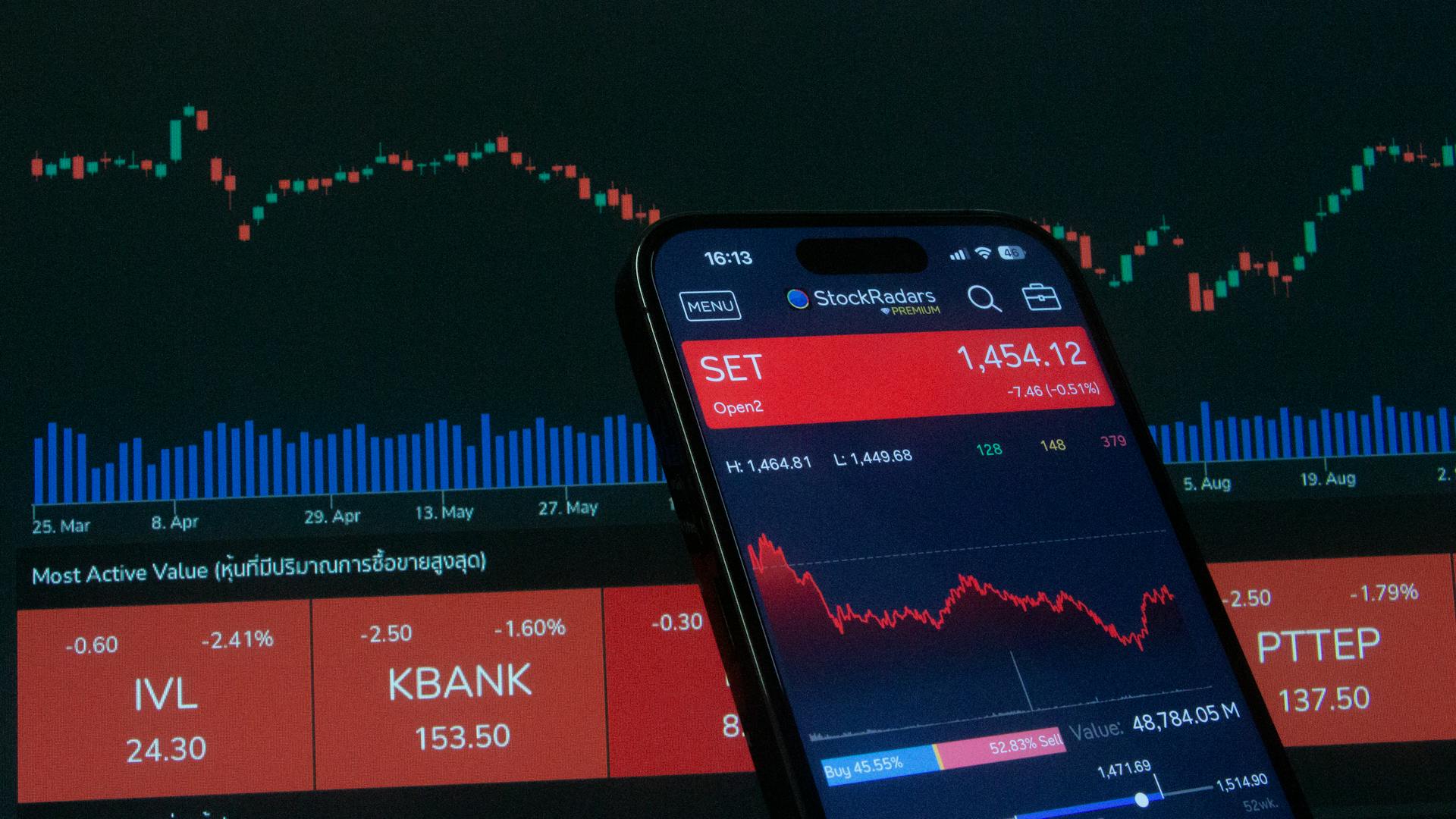
Alternative data is revolutionizing the way we think about finance. It's no longer just about traditional financial metrics like income statements and balance sheets.
By incorporating alternative data, financial institutions can gain a more comprehensive understanding of a company's performance and potential. This can be especially useful for small and medium-sized businesses that may not have a long history of traditional financial data.
For example, alternative data can include social media activity, online reviews, and even weather data. These seemingly unrelated factors can provide valuable insights into a company's customer base, brand reputation, and operational efficiency.
By leveraging alternative data, financial institutions can make more informed investment decisions and better serve their clients.
Intriguing read: UK Financial Investments
What Is Alternative Data?
Alternative data, in the context of finance, refers to non-traditional data sources used to inform investment decisions. This data is often unstructured and can come from various places, such as social media, mobile apps, and online forums.
One example of alternative data is location-based data, which can be used to predict consumer behavior. This type of data can be sourced from mobile devices and can provide insights into where people are going and what they're doing.
Alternative data can be used to gain a more nuanced understanding of a company's performance, beyond traditional financial metrics. For instance, data from online reviews can provide insights into customer satisfaction and loyalty.
Alternative data can also be used to identify trends and patterns that may not be apparent from traditional data sources. By analyzing data from mobile apps, for example, investors can gain insights into consumer behavior and preferences.
A unique perspective: Mortgage Promissory Note Example
What Is It Important?
Alternative data is crucial for hedge funds and investors alike. It offers unique insights and competitive advantages that traditional data sources may not provide.
By October 2020, almost $239B of investments were made with the use of alternative data, highlighting its growing importance in the due diligence process. This includes using satellite images, social media sentiment, and news stories to gain a more comprehensive understanding of a company's performance or potential.
Incorporating alternative data can help hedge funds create more robust and resilient portfolios. By reducing reliance on traditional data sources, hedge funds can access a broader range of information that can lead to better-informed decisions.
Here are some ways alternative data contributes to diversification:
- Uncovering new opportunities: Alternative data can reveal opportunities that may be overlooked when relying solely on traditional data sources.
- Reducing information asymmetry: Access to alternative data sources can level the playing field for hedge funds, allowing them to make more informed decisions.
- Improving portfolio construction: Incorporating alternative data into portfolio construction can help identify and invest in assets with lower correlations to existing holdings.
- Adaptive investment strategies: Alternative data can provide timely insights into changing market conditions, allowing hedge funds to adapt their investment strategies accordingly.
Types and Examples
Alternative data can be sourced from a wide variety of non-traditional sources, including geolocation data, credit card transactions, and social media posts.
Some examples of alternative data include web traffic, mobile app analytics, and satellite imagery. These data sources can provide unique insights into consumer behavior, market trends, and business performance.
Alternative data can also include obscure city hall records, shipping container receipts, and product reviews. These data sources can help investors gain a deeper understanding of companies, industries, and markets.
Here are some specific examples of alternative data:
- Web traffic data: Visitor statistics, bounce rates, and engagement metrics for websites.
- Social media data: Posts, mentions, and sentiment analysis from platforms like Twitter and Instagram.
- Satellite imagery: Visual data of agricultural fields, urban development, or shipping ports.
- Credit card transaction data: Aggregated and anonymized consumer spending insights.
- Foot traffic data: Data on visitor patterns and movements around physical locations.
Definition of a Set
A set is a collection of unique items, like a basket of apples. Each item in a set is distinct from the others.
Think of a set as a container that holds a specific number of items, just like how a social media platform collects a certain number of user interactions.
What Are Examples of

Alternative data is a broad term that encompasses various non-traditional data sources that can provide unique insights into companies, industries, and markets. Examples of alternative data include social media activity, satellite imagery, web traffic, and credit card transaction data.
These data sources can offer valuable information about consumer behavior, market trends, and company performance, which can be used to make more informed investment decisions. For instance, social media sentiment analysis can help investors gauge public opinion and sentiment about a specific topic, product, or company.
Some other examples of alternative data include:
- Satellite imagery for agricultural analysis
- Transactional data from credit card purchases
- Web traffic data
- Social media data
- Foot traffic data
These data sources can provide valuable insights into consumer behavior, market trends, and company performance, which can be used to make more informed investment decisions. By leveraging alternative data, investors can gain a competitive edge in the market and make more informed decisions about their investment strategies.
Alternative data can also be used for predictive modeling, risk assessment, and market analysis. For example, investors can use alternative data to forecast market trends and stock performance, or to evaluate potential disruptions or opportunities in specific industries.
Expand your knowledge: Impact Investing Trends
Data Collection and Sources
Collecting alternative data can be a challenge, especially when it comes to large companies with numerous points of interest. Manually scraping data from the internet can be time-consuming and difficult due to the ever-changing nature of the information.
Automating data scraping with tools like Bright Data's Data Collector can make the process easier and more efficient. This allows you to extract specific data from targeted websites and receive it in your desired format.
Public data sources include social media websites like Twitter, review sources like Amazon, and geo-information sources like Google Maps or Waze. Paid data sources, on the other hand, include location tracking services like SafeGraph, Skyhook Foursquare, and Unacast.
Alternatively, you can also collect data from IoT devices and sensors, which can provide valuable insights into business activity.
How to Collect?
Collecting alternative data can be a challenge, especially when dealing with large companies. You can collect it manually online by looking up press releases, checking Glassdoor, or visiting Amazon to read customer reviews and employees' experiences.
However, manually scraping alternative data can be time-consuming and challenging due to the ever-changing nature of the information on the internet.
Bright Data's Data Collector can automate data scraping and extract any data you want from targeted websites, sending it to you in your desired format, such as CSV or JSON.
Public data sources include social media websites like Twitter, review sources like Amazon, and geo-information sources like Google Maps or Waze.
Paid data sources include location tracking services like SafeGraph, Skyhook Foursquare, and Unacast, which provide exclusive and proprietary sets of alternative data.
Microsoft's Azure Maps is another paid resource that shares satellite images and IP traffic data, which can be used to learn more about foot traffic or business activity in a specific area.
You can also use Bright Data's Data Collector to access exclusive alternative data, such as customer reviews, trend demographics, and more.
Here are some examples of public and paid data sources:
- Public data sources:
- Social media websites like Twitter
- Review sources like Amazon
- Geo-information sources like Google Maps or Waze
- Paid data sources:
- Location tracking services like SafeGraph, Skyhook Foursquare, and Unacast
- Microsoft's Azure Maps
Geographical Footprint
Monitoring a company's geographical footprint can be a valuable tool for investors. It can reveal the competition they face, their geographical positioning, customer reviews, and more.
A company's list of stores on its website can be analyzed to gain insight into their geographical footprint. This can be especially useful for investors in markets like retail and logistics.
The hedge fund that invested in a Chinese forestry company in 2012 should have conducted a geographic footprint analysis to reveal the true value of the company's forestry assets. This could have prevented a lawsuit from its clients.
Physical presence matters in certain markets, and a company's geographical footprint can be a key indicator of their success. Investors can use this information to make more informed decisions about their investments.
By analyzing a company's geographical footprint, investors can get a better sense of their competition and market position. This can be especially useful for investors who can't physically inspect the locations.
Suggestion: Robinhood Markets Inc Earnings
Cases & Sources
Investors use alternative data for predictive modeling to forecast market trends and stock performance. This unique approach helps them make more informed decisions about their investment strategies.
Alternative data supports market analysis by offering granular insights into consumer behavior and business dynamics. By analyzing this data, investors can identify potential investment opportunities and risks.
Investment research and analysis rely heavily on alternative data, which provides valuable information about consumer behavior, market trends, and company performance. This data can be sourced from various places, including social media sentiment and web scraping.
Social media sentiment is one of the alternative data sources used in investment research and analysis. It helps investors understand consumer behavior and sentiment towards specific companies or industries.
Credit card transactions and satellite imagery are also used as alternative data sources in investment research and analysis. These data sources provide valuable insights into consumer behavior and market trends.
Investors use alternative data to evaluate potential disruptions or opportunities in specific industries. This helps them make more informed decisions about their investment strategies and identify potential risks or opportunities.
Consider reading: Private Equity Market Trends
Risk and Security
Vendor risks are a common issue in the alternative data industry, particularly due to changes in data collection methodology or terms of use. Established escalation protocols, client notification practices, and processes to monitor adverse events can help mitigate these risks.
Firms should periodically reassess vendors to minimize vendor risk, with the plan for reassessment documented and results tracked. This can help prevent adverse events and ensure compliance with regulatory requirements.
Regulatory risks are also a concern, especially when using alternative data containing sensitive information like MNPI and PII. Firms must have written policies and procedures to address these risks, and be selective in choosing vendors that align with regulatory guidelines.
To minimize regulatory risks, firms can train analysts on issues specific to alternative data, and look for vendors with documented due diligence processes and compliance with regulatory requirements.
The security of alternative data is a top priority, with industry standards like encryption, anonymization, and secure delivery methods enforced to protect sensitive information.
Broaden your view: List of Impact Investing Firms
Is Secure?
Alternative data is secured through compliance with industry standards, including encryption, anonymization, and secure delivery methods like SFTP and APIs.
Encryption is a key aspect of securing alternative data, ensuring that sensitive information is protected from unauthorized access. Organizations that handle alternative data must adhere to regulations such as GDPR, CCPA, and other relevant data protection standards.
Strict policies are enforced by companies like Datarade, requiring all their providers to follow these regulations and ensure the secure handling of alternative data.
Risk and Fraud Detection
Alternative data can be a powerful tool in risk and fraud detection, allowing organizations to better assess and mitigate potential risks.
Credit card companies can analyze transaction data to identify fraudulent activities and prevent financial losses.
Insurance companies can leverage alternative data to assess the risk profile of policyholders and determine appropriate premiums.
By incorporating alternative data into risk models, organizations can enhance their risk management practices and improve fraud detection capabilities.
Related reading: Bill Ackman Fraud
Here are some ways alternative data contributes to enhanced risk management:
- Identifying hidden risks: Alternative data can uncover potential risks that may not be evident from traditional financial data.
- Stress testing and scenario analysis: Hedge funds can use alternative data to conduct stress tests and scenario analyses, helping them better understand the potential impact of various risk factors on their investments.
- Tail risk management: Alternative data can help hedge funds identify and manage tail risks or extreme events that have a low probability of occurrence but could result in significant losses.
- Quantitative risk modeling: Incorporating alternative data into quantitative risk models can enhance their accuracy and predictive power.
- Monitoring correlations: Alternative data can help hedge funds identify and monitor correlations between different assets, industries, or markets.
To minimize vendor risks, firms should establish escalation protocols, client notification practices, and processes to monitor adverse events.
Talent Risk
The talent risk is a significant concern for investment management firms. High turnover among data science professionals can slow down the integration process. The shortage of data science professionals is a major factor fueling this high turnover. About 16% of data science job positions in the US are expected to remain vacant in 2031.
The demand for data science professionals is extremely high, with the number of job postings doubling over the past decade. This doubling happened from 12% in 2011 to 24% in 2022. Investment management firms are competing for talent not just with industry peers but also with other industries.
You might enjoy: Impact Investment Firms
Management and Integration
To truly integrate alternative data into the investment decision process, firms should align people, process, and technology.
Leadership communication is key to bringing stakeholders across departments on the same page, including proof of alternative data's alpha generation potential.
Identifying risks and establishing controls is crucial to minimize additional risk for investment management firms, and this involves integrating alternative data into the investment decision process.
Balancing priorities across business functions and departments is essential for successful implementation of alternative data, requiring alignment of priorities and buy-in from stakeholders.
Improved Risk Management
Improved Risk Management is a crucial aspect of investment decisions. Alternative data can provide additional insights into potential risks associated with investments, helping hedge funds make better-informed decisions and manage their risk exposure more effectively.
Alternative data can uncover potential risks that may not be evident from traditional financial data, such as shifts in consumer sentiment, supply chain disruptions, or emerging regulatory issues. This enables hedge funds to proactively manage these risks and adjust their investment strategies accordingly.
Hedge funds can use alternative data to conduct stress tests and scenario analyses, helping them better understand the potential impact of various risk factors on their investments and develop strategies to mitigate these risks.
Curious to learn more? Check out: Capital Budgeting Decisions Include
Alternative data can help hedge funds identify and manage tail risks or extreme events that have a low probability of occurrence but could result in significant losses. By incorporating alternative data into their risk management process, hedge funds can better prepare for and mitigate the impact of these events.
Here are some ways alternative data contributes to enhanced risk management:
- Identifying hidden risks
- Stress testing and scenario analysis
- Tail risk management
- Quantitative risk modeling
- Monitoring correlations
Incorporating alternative data into quantitative risk models can enhance their accuracy and predictive power, allowing hedge funds to better measure and manage various types of risk, such as market risk, credit risk, and operational risk.
Assigning Accountability
Assigning accountability is crucial for the success of an alternative data strategy at investment management firms. A passionate internal data champion, backed by a team with a deep understanding of alternative data, is needed to drive the agenda and provide stewardship.
Having a robust execution plan and assigning specific responsibility for data utilization, analysis, and management to all stakeholders can help ensure accountability extends beyond siloed functions. This can ease the pressure on the chief data officer, a role with high turnover due to poorly defined roles and complicated cross-departmental coordination.
Increased accountability can help drive the alternative data strategy agenda forward and improve communication and collaboration across teams. It can also lead to better cultural outcomes.
Readers also liked: Investor Relations Strategy
Storage
Storage is a crucial aspect of data management, and it's essential to store data sets securely with precise access rights.
Locating and understanding data is a significant challenge when browsing through large repositories of data. Data set definitions and metadata are key components of data storage that help firms use data effectively.
Effective data curation is vital to deriving value from alternative data. Combining information from different data sets can lead to better insights.
Defining access rights can help organizations strengthen their cybersecurity posture as they transition to cloud data management.
Frequently Asked Questions
How much do hedge funds pay for alternative data?
Hedge funds spend an average of $2.6 million on alternative data in 2020, a significant increase from $841,000 in 2016. This growing investment in alternative data is expected to reach $7 billion by 2020.
What is the future of alternative data?
The alternative data market is expected to reach $135.8 billion by 2030 with a growth rate of 52.1% CAGR, indicating a rapidly expanding future. This growth is driven by increasing demand for alternative data in industries such as finance and healthcare.
Sources
- https://en.wikipedia.org/wiki/Alternative_data_(finance)
- https://www2.deloitte.com/us/en/insights/industry/financial-services/alternative-data-for-investors-from-discovery-to-institutionalization.html
- https://research.aimultiple.com/alternative-data-use-cases/
- https://datarade.ai/data-categories/alternative-data
- https://www.promptcloud.com/blog/why-alternate-data-is-important-for-hedge-funds/
Featured Images: pexels.com


